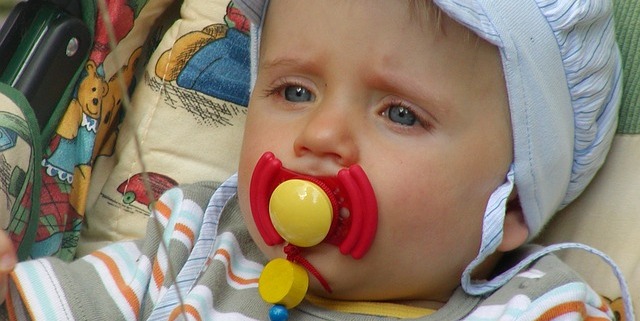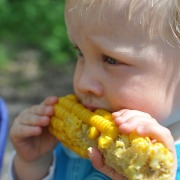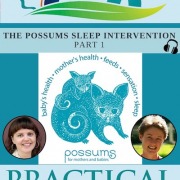Young children suck…breasts, bottles, thumbs, dummies (pacifiers), fingers…
The instinct to suck is present moments after birth and plays a crucial role in supporting babies’ early growth and development. Like sexual behaviour, sucking has a predictable developmental trajectory. It is strongest in infancy and gradually fades as children age. There are individual differences in the degree to which children suck and how the developmental trajectory unfolds and, of course, the trajectory for an individual child will be affected by a whole range of contextual factors. The ‘average’ age to spontaneously stop sucking seems to be somewhere between two and four with anywhere between one and seven within the bounds of ‘normal’. This is true of breastfed babies allowed to self-wean and thumb-suckers allowed to stop sucking when they wish and is consistent with patterns of nursing and weaning in other primates.
Sucking is right up there with eating, drinking and sexual behaviour as utterly crucial to our survival as a species. For our ancestors, a baby with a poor sucking instinct was likely to die. A child who lost the drive to suck early in infancy was at risk of death or injury due to infection or malnutrition. In an era without formula, antibiotics or hospitals, in which access to clean water and a variety of nutritious foods was not always dependable, a desire to suck regularly for years would have increased the chance of survival. Childhood sucking is underwritten by instincts and desires shaped by millions of years of evolution. How does evolution ensure that we perform the behaviours that are utterly crucial to the survival of the species? By making them highly reinforcing – pleasurable, comforting, satisfying. So just as the evolutionary ‘purpose’ of sexual behaviour is reproduction but many people all over the world regularly engage in sexual behaviour for satisfaction, the evolutionary ‘purpose’ of childhood sucking is to support growth and development through nutrition and immunological benefits but many children all over the world regularly engage in sucking behaviour for comfort. And this is just as natural, normal and psychologically healthy for a young child as having sex for pleasure is for an adult. Evolution has also co-opted both sexual behaviour and sucking (as well as physical contact more broadly) to help bind us to each other. When comforting childhood sucking experiences are shared with another person (regardless of what exactly is being sucked) they can promote bonding. If this happens regularly, then sucking behaviour also gets jumbled in with all sorts of social reinforcers in a complex way.
So, are there any risks to childhood sucking? The main risk is dental problems. Sucking a thumb, finger or a dummy, particularly beyond two years of age does increase the risk of developing specific dental problems. However, the majority of children who do continue to suck beyond two years of age don’t develop these specific dental problems and some children who are not sucking a thumb, finger or a dummy beyond two years do. It is clear that the longer the sucking behaviour persists the higher the risk but what I’ve found disappointingly unclear within the scientific literature is the dosage of sucking required to create the risk. In other words, exactly how much sucking is needed before your child’s dentation is at risk? One minute a day? Ten? An hour? Two hours? Without knowing the dose relationship it is hard to judge the risks involved in the sucking behaviour of a particular child, and hence it is hard for a parent to judge how much they should prioritise the elimination of risks to dentation over other considerations such as their child’s emotional needs or the promotion of autonomy or a peaceful family life. To be a bit facetious, many behaviours performed repeatedly may leave their mark upon the body, but we usually don’t recommend that the behaviours be eliminated entirely. The other potential for dental problems is clear. Sucking from a bottle allows the liquid to wash over teeth so only breastmilk, formula or water should be put in a bottle.
So, can sucking be a habit? Sure. The specific ways a child sucks are obviously learnt and at times, children suck because it is a ‘habit’ just as at times adults engage in particular sexual behaviours because it is a ‘habit’. But assuming sucking is ‘just a habit’ is a mistake and underestimates the potential importance of sucking for your child.
So, what can parents do?
Firstly, think about how all of this best fits into your family, your values and your circumstances and how all of that will unfold for you throughout early childhood. For example, it isn’t wise to introduce a dummy (pacifier) before you’ve at least considered how and when your child might finish dummy (pacifier) sucking.
Breastfeed if you can. If there are downsides of breastfeeding for you, or if you find that you struggle with breastfeeding and seeking professional help doesn’t solve the challenges that you experience know that this isn’t all or nothing. Any breastfeeding you’ve managed to do is a brilliant achievement. And your choices from here on aren’t just black and white, there are shades of grey. For example, expressing milk (without pressure, just when you can) and feeding it to your baby from a bottle, combination feeding (breastfeeding and formula feeding too) or feeding your baby mostly on formula but continuing to offer the breast for comfort. You can also mimic breastfeeding in how you bottle feed and gain all the non-milk benefits of breastfeeding (see below). If you do successfully establish a happy breastfeeding relationship then continue to breastfeed for as long as suits you and your child. Breastfeeding, even for months, decreases the chance that your child will persist in sucking their thumb or finger or a dummy (pacifier).
For all sucking other than breastfeeding, try to imitate breastfeeding. Breastfeeding automatically puts specific boundaries on sucking behaviour. For example, when breastfeeding:
- sucking is always paired with physical contact
- feeding usually happens by demand not by schedule (breastfeeding doesn’t tend to work if it is done on schedule)
- the child regulates their own intake, stopping a feed when they are satisfied
- babies often fall asleep at the breast
- for older babies and toddlers, there are times when the sucking object is unavailable or when access is delayed (because mum is somewhere else or busy)
- for older babies and toddlers, sucking can’t be done at the same time as crawling, walking or running, so children have to choose between comfort and exploration
You can replicate these same conditions with other forms of sucking. For example, when you bottle feed (regardless of whether there’s expressed milk or formula in the bottle), always hold your baby at the same time, pairing sucking with physical contact. Feed your baby by demand, not by the clock and allow your child to regulate their own intake instead of encouraging them to finish the bottle. If you introduce a dummy (pacifier) then you can place boundaries on its use, for example, only giving it when your baby is tired, as part of settling for sleep. You can pair physical contact with dummy (pacifier) and thumb or finger sucking by regularly giving cuddles at the same time. For toddlers, you could even negotiate rules around sucking happening during cuddle time or when settling to sleep, not during play.
Allowing your child to choose when to finish sucking is a legitimate option and if you go down that path your child will probably finish sucking altogether somewhere between their second and their fourth birthdays. Within the breastfeeding literature this is called child-led weaning. It is a gradual process, you will notice your child gradually cutting back on sucking over time, long before they finish sucking altogether. If you decide it is time for your child’s sucking to end or to be reduced it is possible to bring this about in a gentle and gradual way. Within the breastfeeding literature this is called mother-led weaning but the same strategies can be used with all forms of sucking. When breastfeeding, a gradual weaning process is always advised as sudden weaning risks blocked milk ducts and infection in the mother. However, a gradual weaning process is also gentler for the child and should be considered the best option with all forms of sucking. Again, child-led weaning vs mother-led weaning isn’t black and white, there are many shades of grey in between. You might, for example, wait for your child to initiate cutting back on sucking and then actively assist this to happen, or you might negotiate specific boundaries around sucking behaviour, cutting back to a small amount of sucking per day and then allow your child to finish sucking altogether whenever they wish. To encourage your child to gradually cut back on sucking you might like to experiment with:
- Start by cutting back on your child’s least favourite feed or sucking time. Target their favourite time to suck last.
- Don’t offer and don’t refuse. This is often used to wean from the breast but it can also be effective with dummies (pacifiers). Start keeping your child’s dummy (pacifier) out of sight and never offer it again. If your child asks for it, give it.
- Negotiate a boundary to sucking. For example, ‘only at home’.
- When targeting a specific sucking time, focus not on eliminating the sucking but on the new behaviour that will happen instead. For example, if your child likes to suck to sleep at night, you can try experimenting with new bedtime routines such as reading a book, doing a relaxation exercise or having a cuddle. Continue to offer sucking after the new routine if your child is still awake. Keep experimenting until you find that your child begins to fall asleep before sucking. As another example, if your child likes to suck in the morning just after waking for the day, you can try experimenting with new morning routines, ensuring that you are available for an enjoyable play just after your child wakes.
- Do all of this flexibly, experimenting to find what works, and with full consideration of your child’s perspective.
The bottom line? Remember, your child’s need to suck is a powerful and necessary force shaped by millions of years of evolution and in early infancy it kept your child alive.
Apply it to your life: Consider your child’s need to suck, and how that may be present in early childhood. How can you best accommodate your child’s needs in your family?
References
Dettwyler K. (1995) A time to Wean: The Hominid Blueprint for the natural age of Weaning in Modern Human Populations. In: Stewart-MacAdam P, Dettwyler KA, editors. Breastfeeding: Biocultural Perspectives. New York: Aldine deGruyter
Duncan, K., McNamara, C., Ireland, A.J. & Sandy, J.R. (2008) Sucking habits in childhood and the effects on the primary dentition: findings of the Avon Longitudinal Study of Pregnancy and Childhood. International Journal of Paediatric Dentistry, 18,178–188
Sugarman M, Kendall-Tackett K.A (1995) Weaning ages in a sample of American women who practice extended breastfeeding. Clinical Pediatrics, 34(12), 642-7.












Leave a Reply
Want to join the discussion?Feel free to contribute!